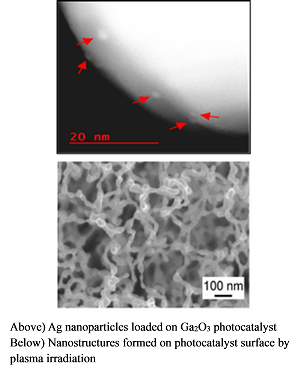Research subjects
For attainment of SDGs, required are efficient use of solar energy, saving of fissile energy, and materials recycling with low environmental load. Artificial photosynthesis is expected as one of the key technologies for that and the development of photocatalysts which enables to reduce CO2 with water into green fuels and/or chemicals using the solar energy.
Our target is synthesis of the wide-gap semiconductor photocatalysts, which show high efficiency in solar energy use and are applicable to practical use or in industrial scale. Specifically, we are investigating (1) synthesis of the photocatalysts, (2) evaluation of them, i.e., characterization of synthesized photocatalysts and analysis of photocatalytic reactions, and (3) elucidation of photocatalytic reaction mechanisms. Applying accumulated experiences and knowledges, development of functional materials such as, catalysts to reduce environmental load of cars and industrial exhausts, metal nano-particles for advanced catalytic reactions, and luminescent materials are also in progress.
Artificial photosynthesis (Reduction of CO2 with water using photocatalyst and solar energy)

Aiming artificial photosynthesis, i.e., conversion of CO2 into green fuels and/or chemicals, such as CO, H2, CH4, CH3OH and so on, photocatalytic reduction of CO2 with water is extensively studied. Recently, remarkable improvement in the photocatalytic CO2 reduction (CO2 + H2O → CO + H2 + O2) is attained with using nano-sized Ag particles deposited on metal oxide catalysts. Phase and morphology controls of Ga2O3 photocatalysts to improve their activity is also examined successfully.
Together with theoretical approaches and analyses of chemical and electronic properties of catalyst surface, which are described separately, detailed mechanisms of the photocatalytic CO2 reduction are being investigated. This allows us to make rational designing of advanced photocatalyst for the conversion of CO2 into green fuels/chemicals.Photocatalytic hydrogen evolution from water or biomass using visible light

Hydrogen evolution from water or biomass with using solar energy is also another target for the attainment of SDGs. Since most of the semiconductor photocatalysts works under UV-light illumination, it is important to develop photocatalysts which work with visble light dominated in the solar light. In this respect, the hydrogen evolution seems more efficient in solar energy use than CO2 reduction. For that purpose, we are investigating modifications of surface nano-structure and electronic structure of metal oxide photocatalysts, applying plasma processing and metal ion doping, respectively. To clarify the role of such modification on the hydrogen evolution, various surface characterization such as observation of morphology changes in nano-scale together with operando observation, UV-Vis absorption, XPS, XAFS, TEM, SEM and other analysis techniques are applied.
Application of quantum calculation for design and evaluation of photocatalysts

Photocatalytic reactions proceed through excitation and transport of electrons in a photocatalyst. Therefore, electronic properties of the photocatalyst plays an essential role on the photocatalytic reactions, and their observations both experimental and theoretical are critically important. We are making quantum calculations of electronic structure of the photocatalyst using computer codes like VASP and WIEN2k. The results are compared with experimental observations of catalytic activity to clarify the role of electronic structures or their changes. Focused are, how electronic structure is changed by doping and/or deposition of nm-sized metallic particles, and how such changes influence the photocatalytic activities. Referring the surface characterization described in the following, improvement of photocatalysts and design of a new one are going on.
Advanced surface analysis in nm scale

For understanding and control of photocatalytic reactions, it is critically important to identify and observe active sites on a photocatalyst. In particular, elucidation of atomic structure or morphology in nm scale of active sites and their electronic structure are really challenging. Since the chemical and physical states of the active sites are likely changing during the photocatalytic reactions, i.e., electron excitation, reaction with absorbates, formation of intermediates and final products and their release, in situ and/or operando observations are required.
We are now developing advanced surface analyses in nm scale combining X-ray absorption (XAFS and XPS) spectroscopy using synchrotron radiation and electron microscopy (TEM STEM and EELS). These analyzing techniques make it possible to identify the active sites in nm scale and to characterize their atomic and electronic structure. With these, nm-scale visualization or mapping of the active sites on the photocatalyst surface becomes possible as shown in the figure. In situ or operando observations of the surface by IR, and absorption and emission of photons, which are challenging, give important information on reaction processes and mechanisms.
As such we are aiming well organized studies to understand the mechanism and find quantitative relationships among various properties of the photocatalyst and their catalytic activities but not screening type trials (experiments). Based on such studies, we believe that rational design and synthesis of advanced photocatalysts are realized.